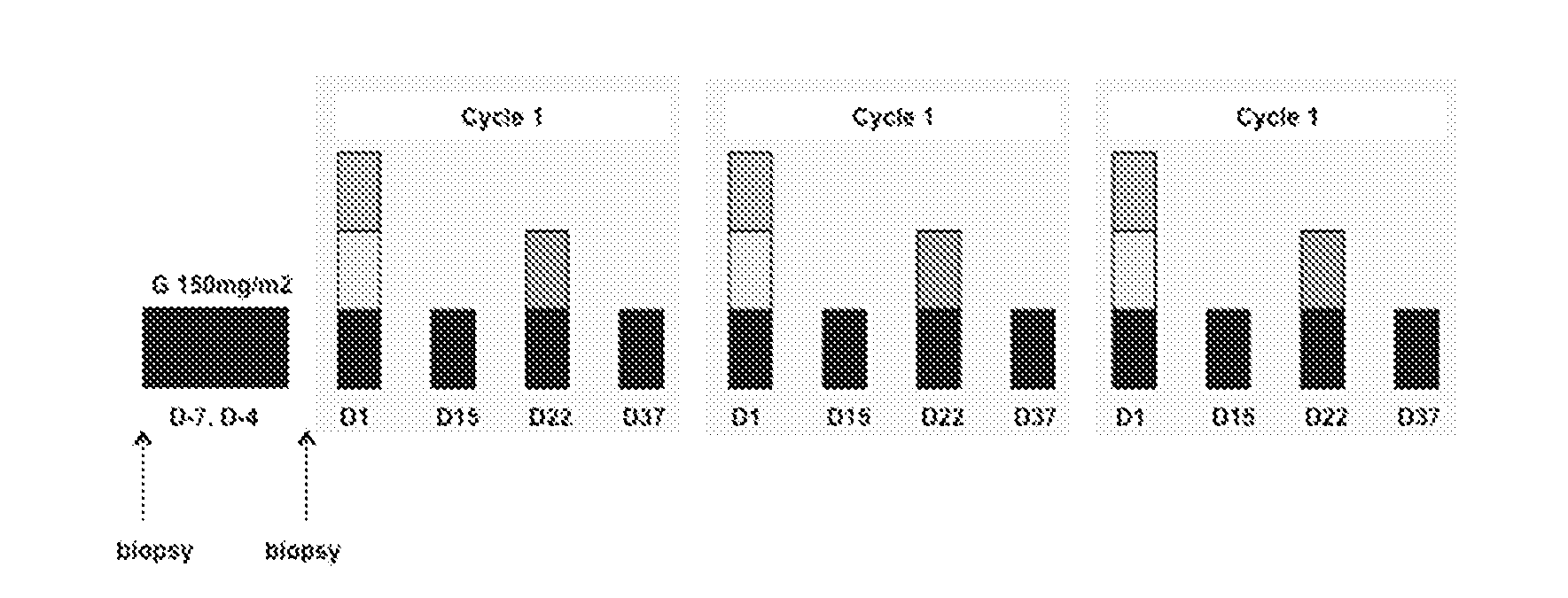Specific cancer treatment regimes with ganetespib
- Summary
- Abstract
- Description
- Claims
- Application Information
AI Technical Summary
Benefits of technology
Problems solved by technology
Method used
Image
Examples
example 1
A Phase I Study of Ganetespib Monotherapy in Treating Solid Tumor and in Combination with Docetaxel in Treating Non-Small Cell Lung Cancer
[0158]A total of 3 (three) cohorts are treated in this study. All patients are hospitalized for the duration of Cycle 1, Days 1 through 21.
[0159]In the first cohort (Cohort 1), patients with advanced solid tumor malignancies are treated with 75 mg / m2 of ganetespib monotherapy. In the second cohort (Cohort 2), patients with advanced solid tumor malignancies are treated with 150 mg / m2 of ganetespib monotherapy. In the third cohort (Cohort 3), patients with advanced NSCLC are treated with ganetespib (150 mg / m2) in combination with docetaxel (75 mg / m2). In the case of intolerability of the third cohort's combination regimen, in a fourth cohort (Cohort 4), patients with advanced NSCLC are treated with ganetespib (150 mg / m2) in combination with docetaxel (60 mg / m2).
[0160]Each cohort enrolls 3 to 6 patients, depending on toxicity and the inclusion of Coh...
example 2
A Phase 1b Study of Ganetespib in Combination with Doxorubicin, Cyclophosphamide and Docetaxel in the Treatment of Inflammatory Breast Cancer
[0178]This is an open-label, multicenter, Phase 1b, dose-escalation study in patients with locally advanced and inflammatory breast cancer. The purpose of the study is to test the safety and tolerability of ganetespib in patients with operable breast cancer.
[0179]Eligible patients must be treatment naïve with histologic confirmation of breast adenocarcinoma, and a tumor that is readily accessible for sequential biopsy. Before the study, patients undergo a complete physical examination, laboratory investigations, chest x-ray, a mammogram and a breast ultrasonography and other imaging studies (e.g., MRI, PET-CT, or mammogram) to determine the local extent of the disease. Abdominal CT scan is performed to exclude metastatic disease. The methods used to document baseline status must be consistently used throughout the study. Prior to entering the s...
example 3
A Phase I Study of Ganetespib in Combination with Cisplatin and Pemetrexed, Carboplatin and Pemetrexed, and Carboplatin and Paclitaxel in Patients with Non-Small Cell Lung Cancer
[0198]This is a Phase 1, open-label, dose-escalation study in patients with advanced NSCLC with adenocarcinoma histology.
[0199]Three cohorts are enrolled:
[0200]Cohort 1: patients treated with ganetespib, cisplatin and pemetrexed
[0201]Cohort 2: patients treated with ganetespib, carboplatin and pemetrexed
[0202]Cohort 3: patients treated with ganetespib, carboplatin and paclitaxel
[0203]Treatment Cycle:
[0204]In Cohort 1, one treatment cycle consists of treatment with ganetespib, cisplatin and pemetrexed on Day 1, and ganetespib on Day 15
[0205]In Cohort 2, one treatment cycle consists of treatment with ganetespib, carboplatin and pemetrexed on Day 1, and ganetespib on Day 15
[0206]In Cohort 3, one treatment cycle consists of treatment with ganetespib, carboplatin and paclitaxel on Day 1, and ganetespib on Day 15
[0...
PUM
| Property | Measurement | Unit |
|---|---|---|
| Electrical resistance | aaaaa | aaaaa |
Abstract
Description
Claims
Application Information
 Login to View More
Login to View More - R&D
- Intellectual Property
- Life Sciences
- Materials
- Tech Scout
- Unparalleled Data Quality
- Higher Quality Content
- 60% Fewer Hallucinations
Browse by: Latest US Patents, China's latest patents, Technical Efficacy Thesaurus, Application Domain, Technology Topic, Popular Technical Reports.
© 2025 PatSnap. All rights reserved.Legal|Privacy policy|Modern Slavery Act Transparency Statement|Sitemap|About US| Contact US: help@patsnap.com


